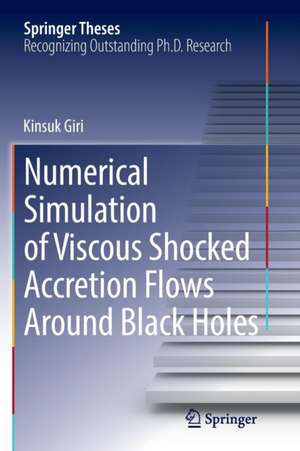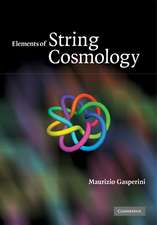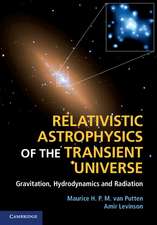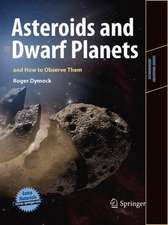Numerical Simulation of Viscous Shocked Accretion Flows Around Black Holes: Springer Theses
Autor Kinsuk Girien Limba Engleză Paperback – 10 sep 2016
| Toate formatele și edițiile | Preț | Express |
|---|---|---|
| Paperback (1) | 379.86 lei 43-57 zile | |
| Springer International Publishing – 10 sep 2016 | 379.86 lei 43-57 zile | |
| Hardback (1) | 386.99 lei 43-57 zile | |
| Springer International Publishing – 12 sep 2014 | 386.99 lei 43-57 zile |
Din seria Springer Theses
- 18%
 Preț: 997.88 lei
Preț: 997.88 lei -
 Preț: 389.88 lei
Preț: 389.88 lei - 15%
 Preț: 646.94 lei
Preț: 646.94 lei - 18%
 Preț: 943.43 lei
Preț: 943.43 lei -
 Preț: 399.29 lei
Preț: 399.29 lei - 18%
 Preț: 944.99 lei
Preț: 944.99 lei - 15%
 Preț: 636.80 lei
Preț: 636.80 lei - 18%
 Preț: 941.05 lei
Preț: 941.05 lei - 15%
 Preț: 643.16 lei
Preț: 643.16 lei - 15%
 Preț: 642.68 lei
Preț: 642.68 lei - 18%
 Preț: 1103.62 lei
Preț: 1103.62 lei - 20%
 Preț: 558.82 lei
Preț: 558.82 lei - 18%
 Preț: 1112.30 lei
Preț: 1112.30 lei - 18%
 Preț: 944.19 lei
Preț: 944.19 lei - 18%
 Preț: 1109.92 lei
Preț: 1109.92 lei - 18%
 Preț: 1217.27 lei
Preț: 1217.27 lei - 15%
 Preț: 640.06 lei
Preț: 640.06 lei - 15%
 Preț: 636.45 lei
Preț: 636.45 lei - 15%
 Preț: 640.06 lei
Preț: 640.06 lei - 15%
 Preț: 640.88 lei
Preț: 640.88 lei -
 Preț: 389.70 lei
Preț: 389.70 lei - 20%
 Preț: 563.89 lei
Preț: 563.89 lei -
 Preț: 393.35 lei
Preț: 393.35 lei - 15%
 Preț: 637.93 lei
Preț: 637.93 lei - 15%
 Preț: 641.85 lei
Preț: 641.85 lei - 18%
 Preț: 1225.94 lei
Preț: 1225.94 lei - 20%
 Preț: 551.36 lei
Preț: 551.36 lei - 18%
 Preț: 1229.10 lei
Preț: 1229.10 lei - 15%
 Preț: 639.25 lei
Preț: 639.25 lei - 18%
 Preț: 999.45 lei
Preț: 999.45 lei - 15%
 Preț: 640.06 lei
Preț: 640.06 lei - 18%
 Preț: 1220.45 lei
Preț: 1220.45 lei - 18%
 Preț: 1116.26 lei
Preț: 1116.26 lei - 18%
 Preț: 1110.72 lei
Preț: 1110.72 lei - 18%
 Preț: 1000.87 lei
Preț: 1000.87 lei - 18%
 Preț: 891.17 lei
Preț: 891.17 lei - 15%
 Preț: 640.06 lei
Preț: 640.06 lei - 5%
 Preț: 1154.07 lei
Preț: 1154.07 lei - 15%
 Preț: 635.96 lei
Preț: 635.96 lei - 15%
 Preț: 640.88 lei
Preț: 640.88 lei -
 Preț: 387.20 lei
Preț: 387.20 lei - 18%
 Preț: 1109.92 lei
Preț: 1109.92 lei -
 Preț: 385.25 lei
Preț: 385.25 lei -
 Preț: 385.25 lei
Preț: 385.25 lei - 18%
 Preț: 1112.30 lei
Preț: 1112.30 lei - 18%
 Preț: 999.45 lei
Preț: 999.45 lei -
 Preț: 386.99 lei
Preț: 386.99 lei - 15%
 Preț: 637.13 lei
Preț: 637.13 lei - 20%
 Preț: 554.20 lei
Preț: 554.20 lei - 20%
 Preț: 555.57 lei
Preț: 555.57 lei
Preț: 379.86 lei
Nou
Puncte Express: 570
Preț estimativ în valută:
72.68€ • 76.09$ • 60.14£
72.68€ • 76.09$ • 60.14£
Carte tipărită la comandă
Livrare economică 07-21 aprilie
Preluare comenzi: 021 569.72.76
Specificații
ISBN-13: 9783319384726
ISBN-10: 3319384724
Pagini: 151
Ilustrații: XXII, 129 p. 54 illus., 8 illus. in color.
Dimensiuni: 155 x 235 x 8 mm
Greutate: 0.22 kg
Ediția:Softcover reprint of the original 1st ed. 2015
Editura: Springer International Publishing
Colecția Springer
Seria Springer Theses
Locul publicării:Cham, Switzerland
ISBN-10: 3319384724
Pagini: 151
Ilustrații: XXII, 129 p. 54 illus., 8 illus. in color.
Dimensiuni: 155 x 235 x 8 mm
Greutate: 0.22 kg
Ediția:Softcover reprint of the original 1st ed. 2015
Editura: Springer International Publishing
Colecția Springer
Seria Springer Theses
Locul publicării:Cham, Switzerland
Cuprins
Introduction.- Overview of Numerical Simulations on Accretion Processes and Our Objectives.- Governing Equations and Computational Methods.- Simulation Procedure and the Test of the Code.- Simulation for Inviscid Sub-Keplerian Flows and Shocks.- Simulation of Viscous Accretion Flows.- Effects of Power-law Cooling in Viscous Flows.- Conclusions and Future Plans.
Notă biografică
Dr. Kinsuk Giri performed his research for his PhD thesis at S.N. Bose National Research Centre for Basic Sciences in Kolkata, India, under supervision of Prof. S.K. Chakrabarti. He was awarded his PhD from Jadavpur University in 2013. Afterwards he took up a postdoc position at the Institute of Astronomy, National Tsing Hua University Hsinchu, Taiwan.
Textul de pe ultima copertă
The work developed in this thesis addresses very important and relevant issues of accretion processes around black holes. Beginning by studying the time variation of the evolution of inviscid accretion discs around black holes, and their properties, the author investigates the change of the pattern of the flows when the strength of the shear viscosity is varied and cooling is introduced. He succeeds to verify theoretical predictions of the so called Two Component Advective Flow (TCAF) solution of the accretion problem onto black holes through numerical simulations under different input parameters. TCAF solutions are found to be stable. And thus explanations of spectral and timing properties (including Quasi-Period Oscillations, QPOs) of galactic and extra-galactic black holes based on shocked TCAF models appear to have a firm foundation.
Caracteristici
Nominated for Springer Theses by S.N. Bose National Research Centre for Basic Sciences, Kolkata, India Instead of assumptions of toy models, this thesis contains step-by-step numerically simulated results to verify the existence of theoretical self-consistent generalized viscous transonic flow shock solutions Demonstrates that the latest ‘Avatar’ of the accretion/outflow picture, the Generalized Two Component Advective Flow (GTCAF), is capable of explaining almost all the black hole observational results Addresses the challenge of approximating the turbulent viscosity Includes supplementary material: sn.pub/extras
















